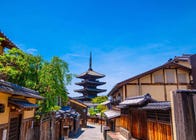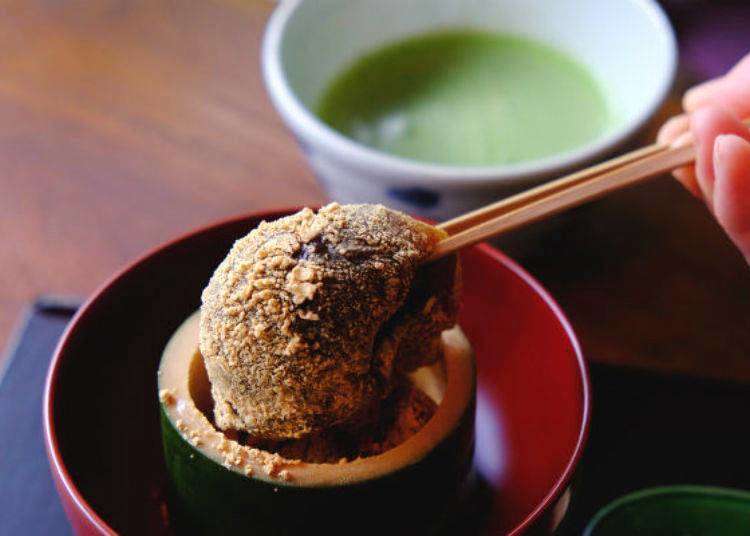
The traditional Japanese sweet you should eat when visiting Kyoto is warabi-mochi - bracken-starch dumplings. These delectable dumplings are incredibly addictive and make a great souvenir for foodies.
Here, we'll share where to find the three best warabi mochi shops in Kyoto so you can get your snack on!
- Table of Contents
-
- What is warabi mochi?
- 1. Yukei Salon De The: Leisurely enjoy the taste of a very exclusive ryokan that is loved by overseas VIPs
- 2. Saryo Hosen: Enjoy a moment of bliss while admiring an elegant Japanese garden
- 3. Gion Tokuya: Warabi mochi in the geisha quarter that’s loved by geisha and maiko
- The best warabi mochi in Kyoto is made with the finest ingredients!
What is warabi mochi?
Warabi mochi dumplings are simply made by kneading bracken-root flour, water, and sugar together. However, it is the quality of the ingredients and the skill of the artisan that determines whether they taste good or not.
Kyoto is home to some of the most skilled traditional sweets craftspersons in the country and it is here where, using the underground spring water, the most delicious warabi-mochi in the country is made.
1. Yukei Salon De The: Leisurely enjoy the taste of a very exclusive ryokan that is loved by overseas VIPs
Yukei Salon De The is a cafe located a 5-minute walk south of the Kyoto Municipal Subway Tozai Line Kyoto City Hall Station. The shop is operated by the luxury inn Tawaraya Ryokan.
Tawaraya Ryokan is a long-established inn well-known for its celebrities in Japan and overseas, including Hirofumi Ito, who served as the first Prime Minister, and Steve Jobs, one of the founders of Apple. Even in Kyoto, where there are many historical inns, it is in a class all of its own.
When greeting guests who are enamored with this inn, they are treated with its popular warabi-mochi, and it is this which has attracted people of all generations, from the young to the old, since the cafe opened in 2007.
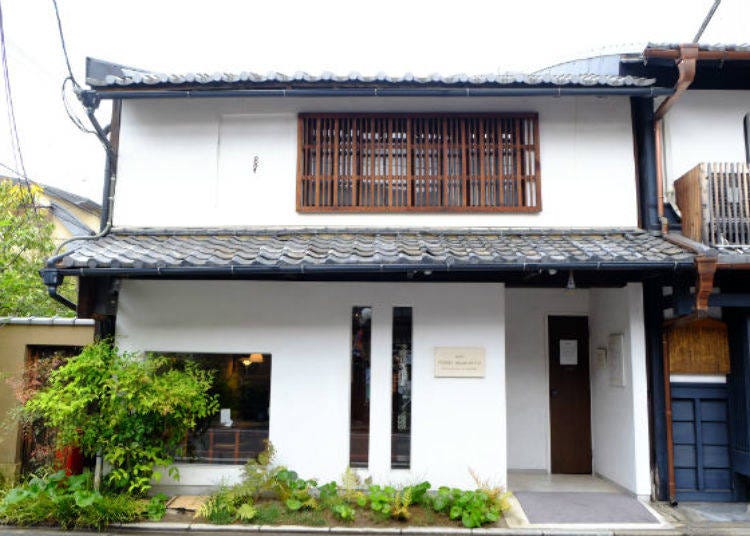
The shop's interior, which is a refurbished merchant house over 100 years old, has been decorated with Scandinavian furniture, and the art collection of the inn's master, Toshi Sato, is displayed throughout. Each with its own unique character blends harmoniously, creating a sophisticated atmosphere.
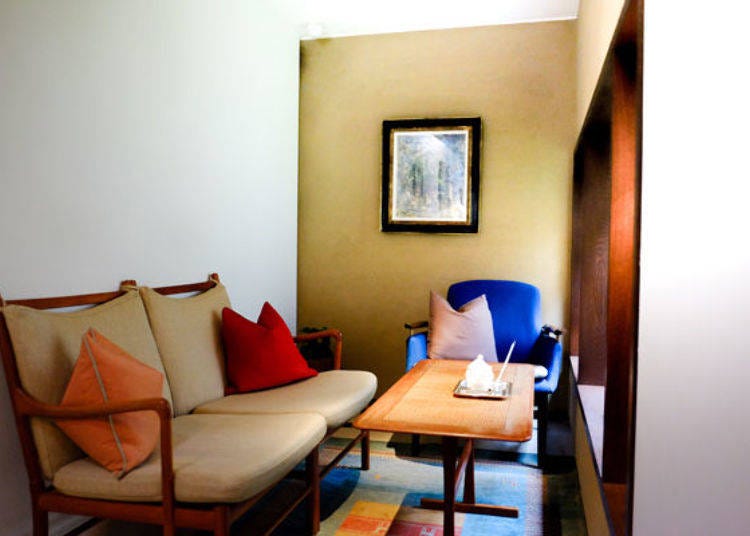
Toshi-san explained her inspiration for opening this cafe. "I wanted to provide a way for those not staying at our inn also to enjoy this sweet." The signature Tawaraya Warabi-mochi in Kyoto is made using only the bracken-root flour, the pure spring water of the Tawaraya Ryokan, and brown sugar.
![▲ Tawaraya Warabi-mochi and Matcha (2,260 yen). In addition, the warabi-mochi can be ordered with either sencha [green tea] or hojicha [roasted green tea] (2,050 yen). Cute Wazanbon sugar dried candy in the shape of tawara [straw bags] representing the name of the inn comes with it.](https://rimage.gnst.jp/livejapan.com/public/article/detail/a/20/00/a2000213/img/en/a2000213_parts_5d67356881023.jpg?20200702161759&q=80)
The warabi-mochi is served in a cool, green bamboo cylinder and liberally dusted with kinako [roasted soybean flour]. It is so soft that when you try to lift it with chopsticks, it begins to ooze away, and just looking at it, you can imagine how it will melt in your mouth.
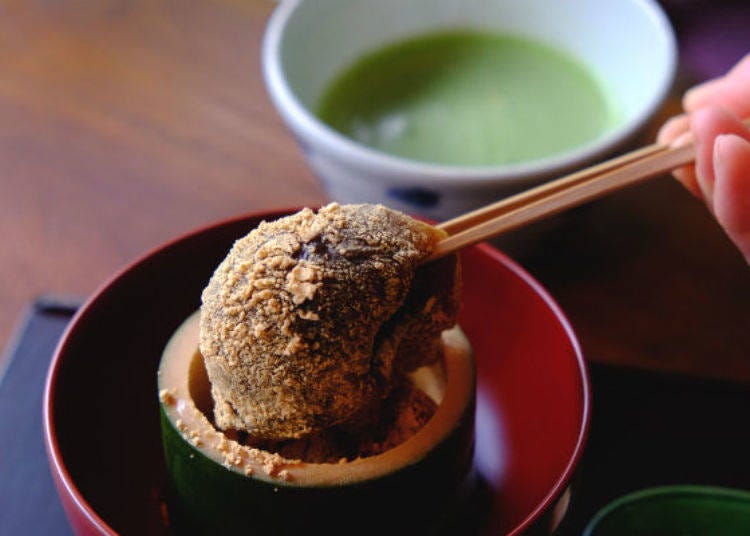
Once you bring it to your mouth, the wonderfully chilled mochi with its rich, sweet brown sugar flavor and kinako aroma slowly spreads over your tongue. Swallowing the slightly springy and delicately soft Kyoto-style mochi, I unconsciously let out a sigh of satisfaction!
When I asked Ms. Ako Ishii, one of the staff, how this unique taste was created, she replied that "the master and head chef spent more than a year experimenting until they finally perfected it." The kitchen staff put their souls into making the warabi-mochi, which is done in the kitchen of the inn every day.
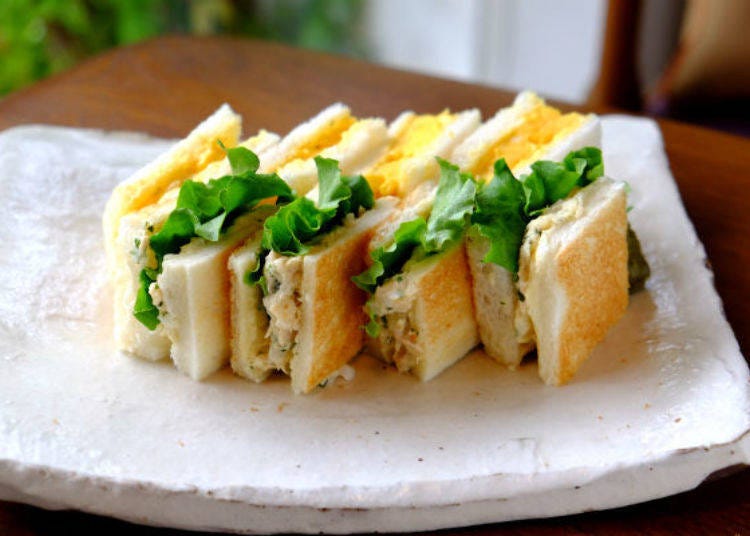
Another popular menu item is this sandwich. This is an original sandwich created and personally made by Toshi-san's late husband, the photographer Y. Ernest Satow, for overseas VIP guests staying at the inn.
There are two types. One is an egg sandwich, and the other is a choice of either tuna, ham, or bacon. The sandwich is seasoned with homemade mayonnaise made with slight hints of basil, parsley, and other herbs taken from the inn's vegetable garden, which gives the sandwich a deeper flavor. The egg is so soft it appears to be about to crumble, the finely chopped onions have a wonderful crunchiness, the herbs give the mellow mayonnaise a refreshing accent...all of this in one sandwich is indeed a work of art and most satisfying.
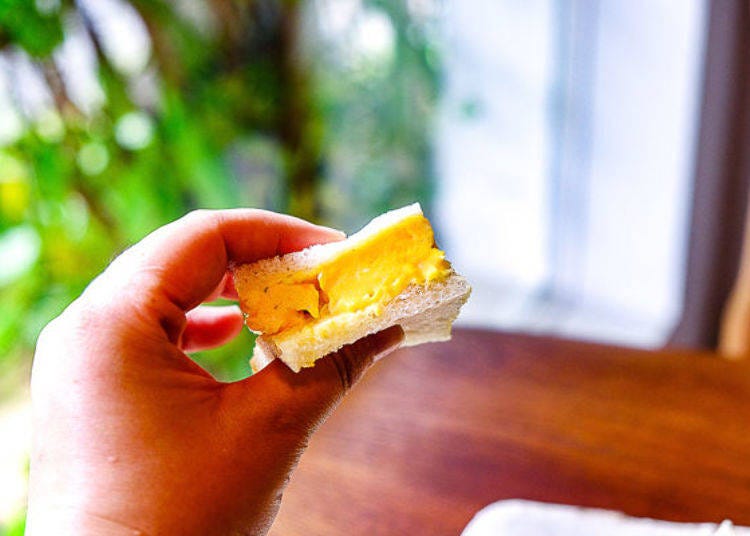
I felt especially fortunate to sample this elegant sandwich which normally is served only to foreign VIP guests, such as actors, musicians, and journalists.
Reservations are unnecessary for the cafe, unlike the Tawaraya Ryokan, which requires them. You can also look at the mossy courtyard at the rear of the shop. Why not come and experience for yourself the exquisite flavor of the best warabi mochi in Kyoto and other dishes of the Tawaraya Ryokan?
-
Yukei Salon De The遊形サロン・ド・テ
- Address 288-14 Nakahakusanchō, Nakagyō-ku, Kyoto City, Kyoto Prefecture
- Phone Number 075-212-8883
・Hours: 11:00 a.m. ~ 6:00 p.m.
・Closed: Tuesday
2. Saryo Hosen: Enjoy a moment of bliss while admiring an elegant Japanese garden
From the bus terminal directly connected to the Kyoto Municipal Subway Kitaoji Station, take the municipal bus Kita 8, 204, or 206 and get off at the Shimogamo Higashihonmachi stop. At the corner of a residential area, you will find Saryo Hosen, which looks like an exclusive Japanese-style restaurant.
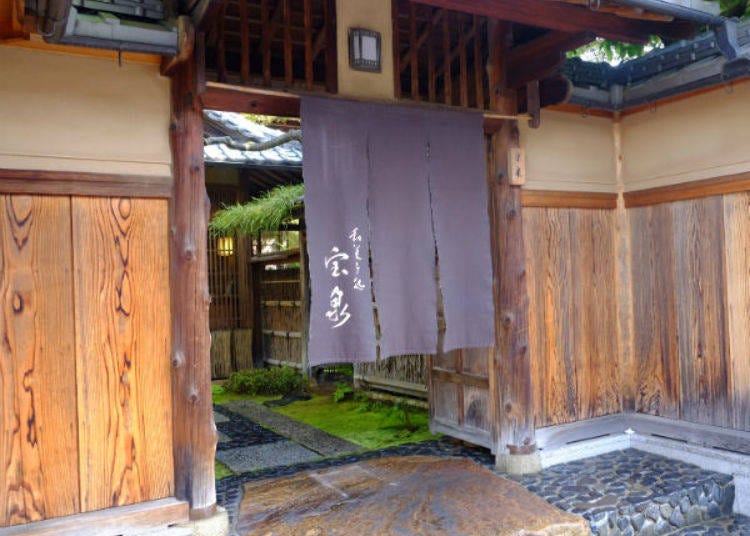
If you are looking for some of the best warabi mochi in Kyoto, then you will find it here at the Hosendo Japanese confectionery with the signboard out front announcing "Azuki Place."
This is a highly acclaimed shop that lovers of traditional Japanese sweets are eager to visit. Here you can savor the shop's proud selection of sweets while admiring the view of a beautiful Japanese garden.
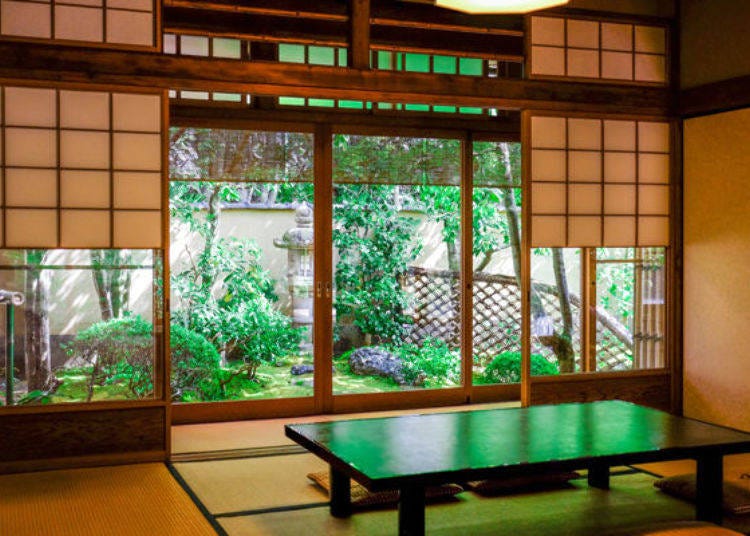
The signature menu item warabi-mochi is handmade only after it has been ordered. It contains no preservatives or additives and is made only with bracken-starch flour, water, and sugar carefully kneaded together. It takes about 15 minutes to make from the time it is ordered. The view of the garden before your eyes is very relaxing and makes the time go by very quickly.
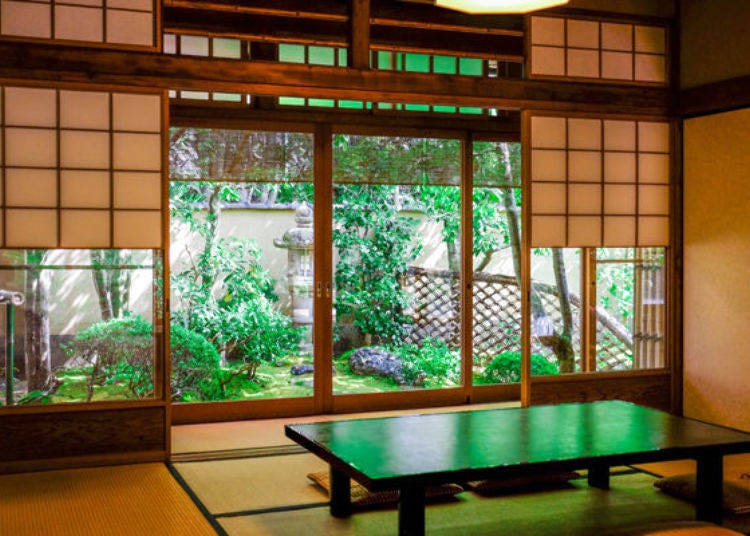
Once the warabi-mochi has been made the shop manager Tomofumi Furuta personally delivers it.
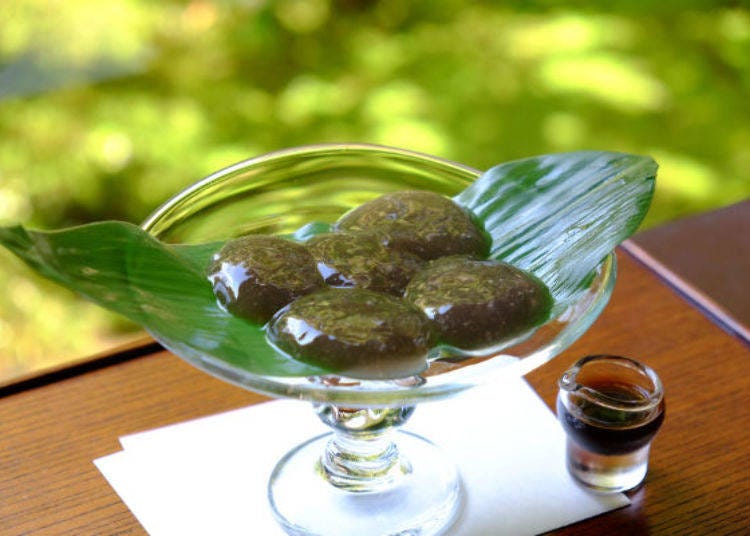
Keeping that in mind, I immediately picked one up with my chopsticks and admired its elasticity! Each plump Kyoto warabi-mochi was bite-sized; the sensation of its shiny surface on my tongue was amazing. The unique aroma of the bracken flour accentuated by the bamboo leaf on which it is served was tantalizing.
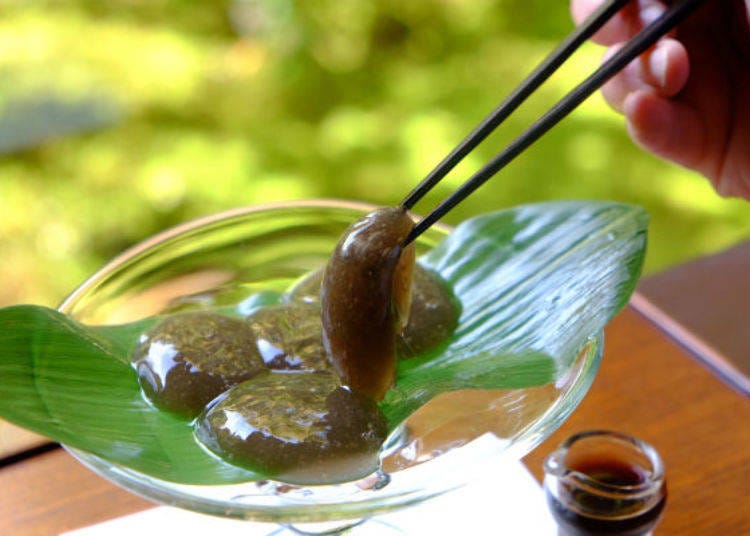
The final pleasure is the sensation when swallowing it. The sweetness lingers even as it goes down smoothly. The fine attention and care that goes into its creation make it so perfect.
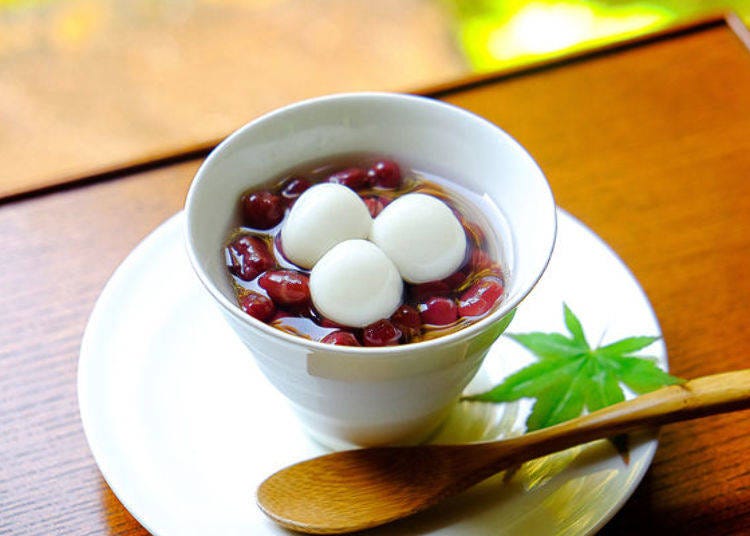
Even in Kyoto, where so many Japanese confectionery shops are found, from long-established shops to new ones, only a few steam red beans to make their own red bean paste.
One such store, Hosendo, carefully selects and uses the highest quality Tamba Dainagon, procured from the country’s top azuki bean production area, the Hikami region of Tamba, and used in the making of coarse sweet red bean paste.
Hosendo, true to being an “azuki place,” we ordered the Dainagon Zenzai made with its homemade coarse sweet red bean paste.
Zenzai is a Japanese sweet served in a bowl, made of azuki red beans, sweetened with sugar, and mochi. At Hosendo, the coarse sweet red bean paste is immersed in syrup and topped with shiratama (rice-flour dumplings) in a simple yet tasteful manner.
The delicious flavor of the red beans is evident in the visual presentation arranged by the shop owner. One spoonful of the delicious coarse bean jam, and you directly feel the flavor gradually unfolding.
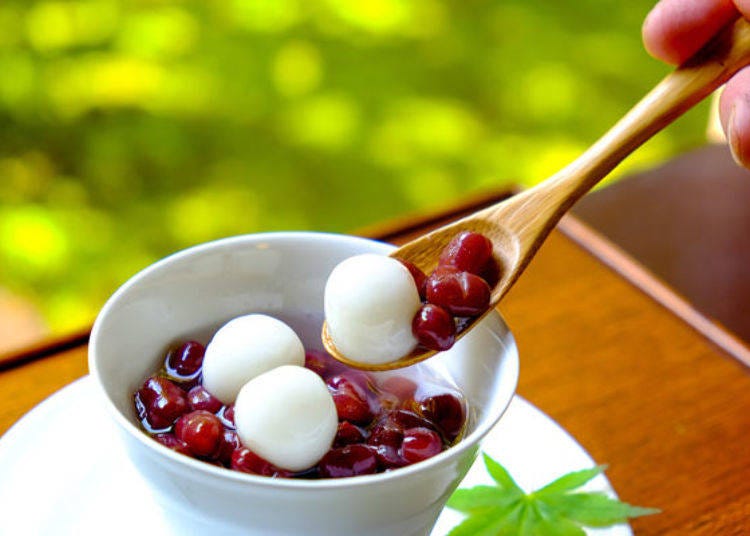
The syrup is not cloudy because it is exquisitely cooked not to break the delicate red bean skin, but to make it as plump as possible. This skill is a trade secret that has been honed by Hosendo through long years of working with azuki beans.
It is not possible to make reservations, so please keep in mind that there usually is a line waiting to get in on weekends and mid-afternoons. We recommend going right after the shop opens.
-
Saryo Hosen茶寮 宝泉
- Address 25 Shimogamo Nishitakagichō, Sakyō-ku, Kyoto City, Kyoto Prefecture
- Phone Number 075-712-1270
・Open: 10:00 a.m. ~ 5:00 p.m. (Last order at 4:45 p.m.)
・Closed: Wednesday, Thursday (if either day falls on a public holiday, open for business as usual and closed the following day)
3. Gion Tokuya: Warabi mochi in the geisha quarter that’s loved by geisha and maiko
Among the entertainment districts in Kyoto, Gion is exceptionally lively. Gion Tokuya is located along the Hanamikoji lane in the center of Gion, an area just a 3-minute walk from the Keihin Main Line Gion Shijo Station.
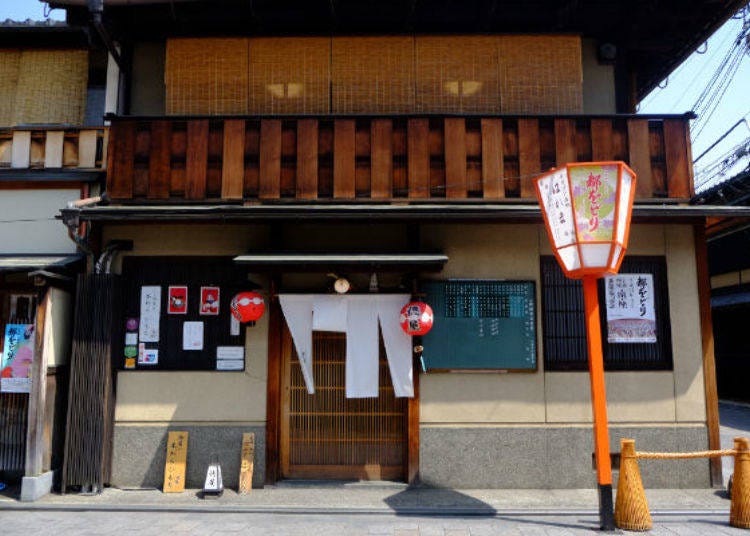
Since the shop opened in 2003, the owner, Shogo Yamauchi, has been offering a number of simple items based on the concept of these being nostalgic treats favored by his grandparents' generation.
The shop uses only natural ingredients, such as pure bracken-starch flour for the warabimochi, pure arrowroot flour from Yoshino for the kuzumochi [arrowroot cake], and rice cakes that can be enjoyed grilled on tabletop stoves.
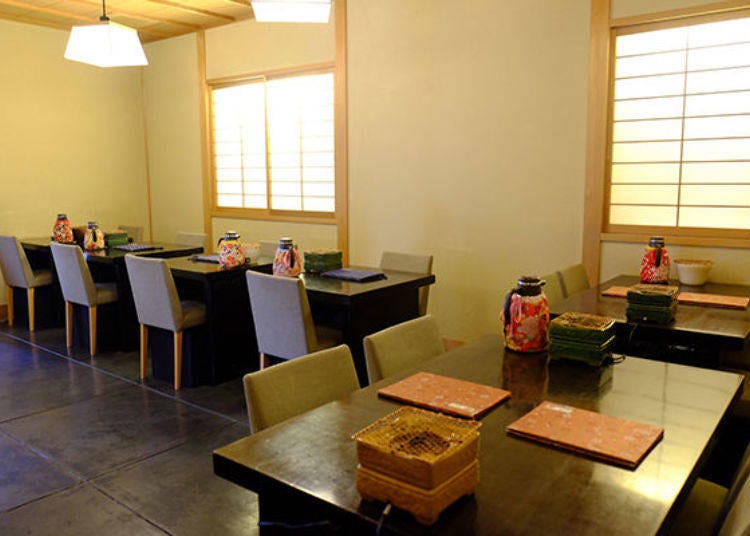
One of the most popular items on the menu is the Tokuya Hon Warabi-mochi. It is made with domestically produced bracken starch, water, and sugar mixed with Wazanbon sugar and made only after being ordered.
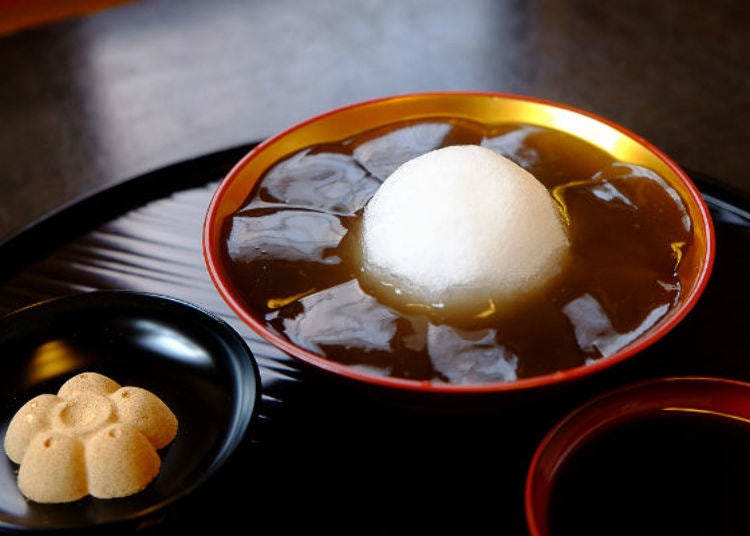
The traditional Kyoto mochi dish is delivered to your table not long after ordering it. First, taste it without dipping it in anything. It is so soft that it takes a bit of effort to pick it up with the chopsticks, but the plump and juicy flavor is a delight once you do and taste it.
After that first bite, try dipping it in the dark molasses and then try it with kinako that comes in the shape of a plum blossom.
The kinako, a unique blend of deep roasted and lightly roasted types and Japanese Wazanbon sugar, will surprise you with its fragrant and deep taste. Furthermore, you can mix the dark molasses and kinako to your own preference, which is a nice touch.
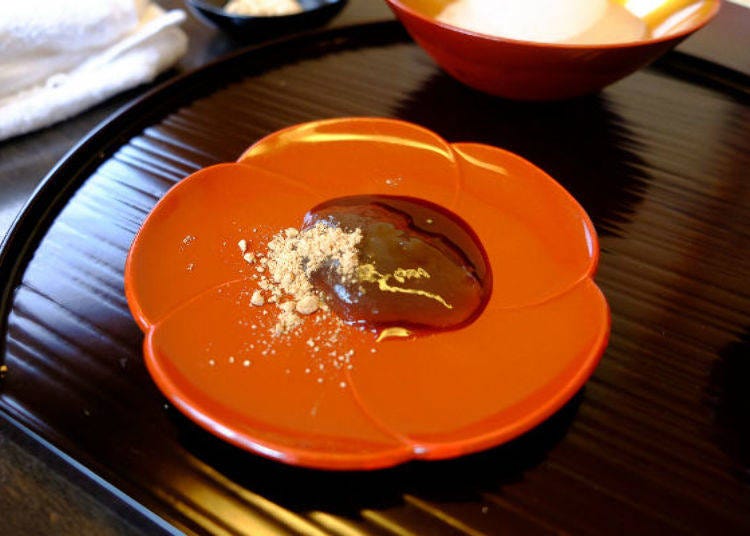
After you have eaten one of the best warabi-mochi in Kyoto, you can mix the remaining dark molasses and kinako and enjoy it poured over the ball of shaved ice. Ice from the Torii Ice Company of Gion is used. The ice from that shop is used in all Gion Tokuya dishes, such as the Special Matcha Uji Kintoki (1,300 yen). The shopkeeper especially likes the fine texture.
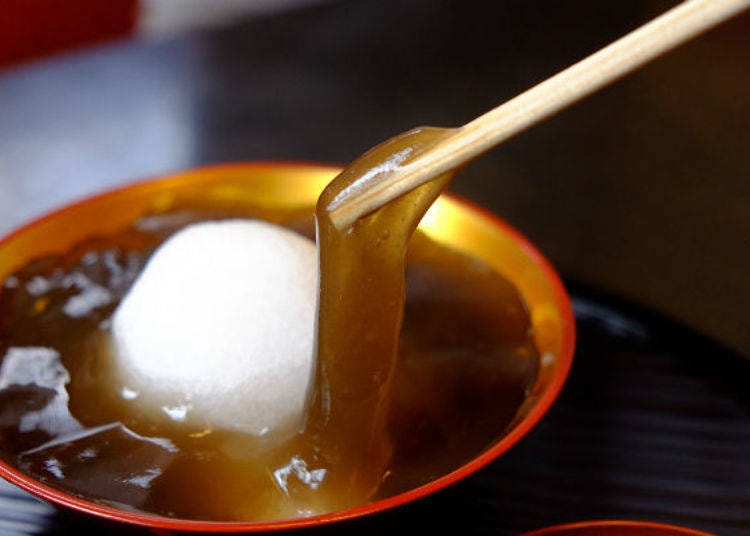
By the way, the eight warabi-mochi are arranged in a round bowl because the shop is located in the entertainment district called Gion Kobu, which uses for its crest eight dumplings connected in a circle. It's a stylish presentation uniquely suited to a shop in the entertainment district.
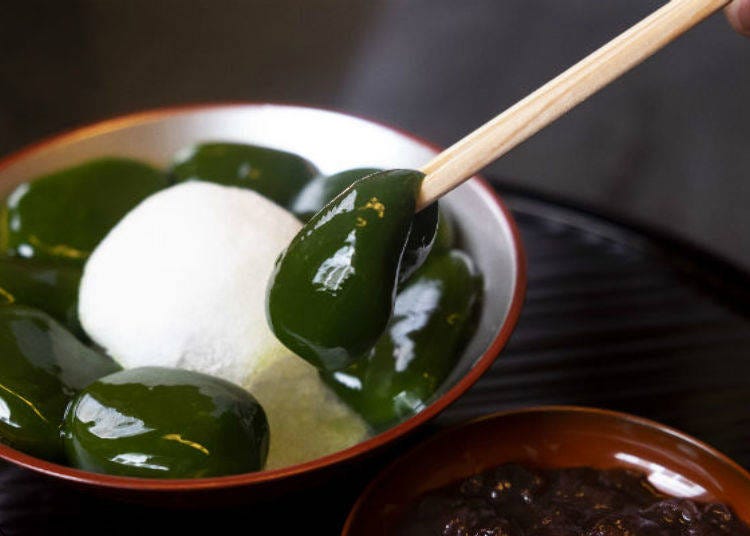
I recommend the Omatcha Hon Kuzumochi. The matcha used comes from the Ryuoen Chaho, which is operated by the family of the proprietress of the famous, old Gion tea house Ichiriki-tei.
Yoshino authentic arrowroot flour, which is highly valued and of the highest quality, is used in the kuzumochi. It seems that only 30 servings per day can be offered because of the time and effort that goes into its careful preparation.
The result is its strong elasticity evident when it is jiggled, not to mention the masterful harmonious touch of tartness following the rich, sweet flavor of the matcha. This is a traditional Kyoto mochi dish I could definitely eat all day.
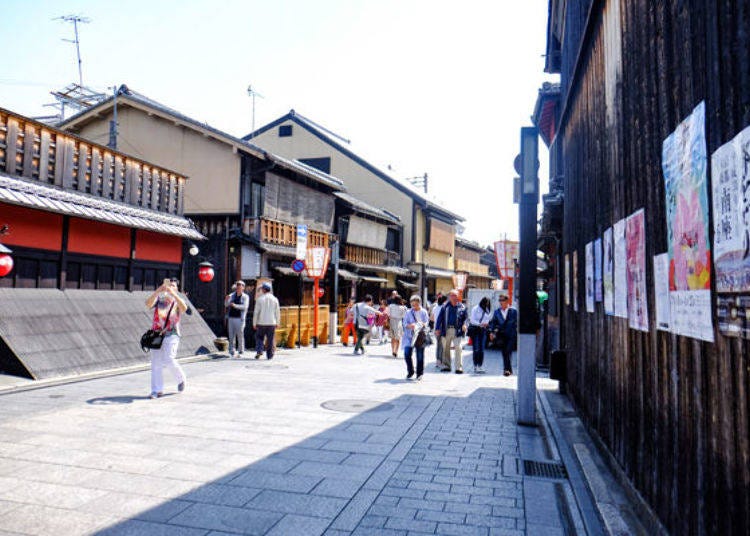
Due to its excellent location, it is busy on weekdays and holidays, so it is better to enter the shop right after it opens. Take a break while watching the people coming and going from the second-floor seating that is rare in Hanamikoji restaurants.
-
Gion Tokuyaぎおん徳屋
- Address 570-127 Gionmachi, Minamigawa, Higashiyama-ku, Kyoto City, Kyoto Prefecture
- Phone Number 075-561-5554
・Hours: 12:00 p.m. ~ 6:00 p.m. *Shop closes when all sold out
・Closed: Open daily
The best warabi mochi in Kyoto is made with the finest ingredients!
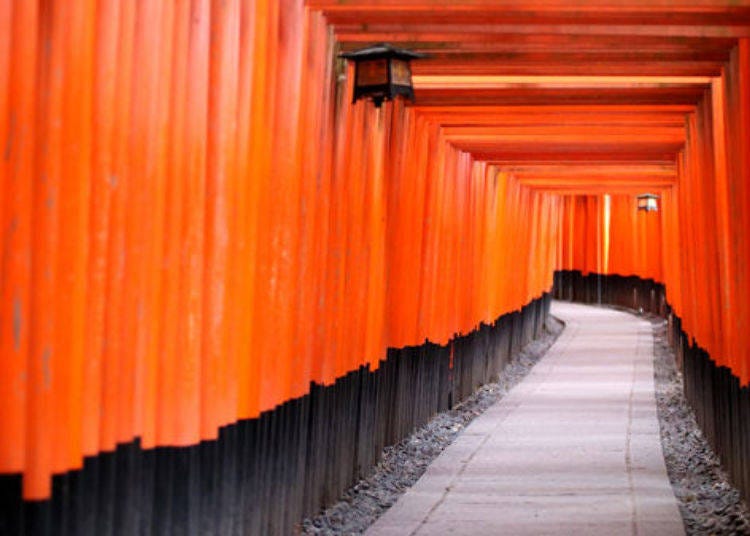
The bracken flour used in all shops introduced above is made domestically. The prices are high because of the limited availability of the ingredients as only the finest quality is used to make Japanese sweets. Because they are so exclusively hard to come by, it does force some traditional sweets shops to use alternative ingredients.
The reason for doing that without hesitation stems from a sincere desire to enable customers to savor the flavor of real warabi-mochi that can only be achieved by using authentic bracken flour.
Not only in the selection of the ingredients but the sincere effort and time devoted to making this traditional Kyoto mochi make it a treat that will further heighten your experiences in the ancient city of Kyoto.
- Area
- Category
*Prices and options mentioned are subject to change.
*Unless stated otherwise, all prices include tax.
Popular Tours & Activitiess
Recommended places for you
-

Tenku cafe
Other Cafes and Sweets
Umeda, Osaka Station, Kitashinchi
-

GiontamejiroGion
Other Cafes and Sweets
Gion, Kawaramachi, Kiyomizu-dera Temple
-

Yoru Parfait specialty restaurant Parfaiteria PaL Shinsaibashi
Other Cafes and Sweets
Namba, Dotonbori, Shinsaibashi
-

Yoru Parfait specialty restaurant number kuma
Other Cafes and Sweets
Namba, Dotonbori, Shinsaibashi
-
Menu

Gionjaya Tabanenoshi Shinkyogoku
Other Cafes and Sweets
Gion, Kawaramachi, Kiyomizu-dera Temple
-

Uji-en KissakoShinsaibashi Main store
Other Cafes and Sweets
Namba, Dotonbori, Shinsaibashi
-

November Events in Kansai: Fun Festivals, Food, and Things to Do in Kyoto & Osaka
-

Everything You Need to Know About teamLab Biovortex Kyoto (2025 Insider Guide)
by: Wemmy Chau
-
Ad

Experiencing Manga as Culture, Not Just Reading It: Expo 2025 with Rumiko Takahashi
-

Kyoto's Hidden Treasures Open This Winter! Enjoy Exclusive Access to 15 Rare Cultural Sites (Jan-Mar 2026)
by: Guest Contributor
-
Ad
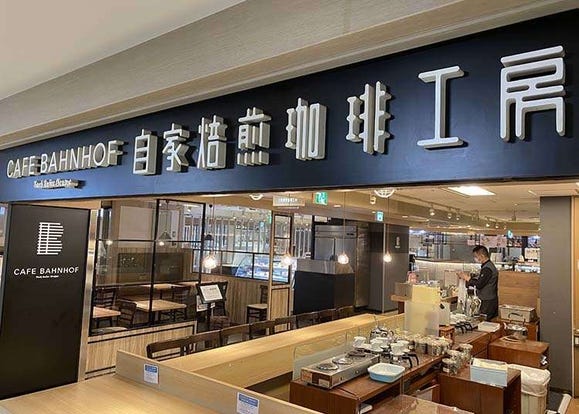
Café Bahnhof in Osaka: The home-roasted coffee that captivated G20 leaders!
-

A First Look at NEMU RESORT’s 2026 Grand Renewal in Ise-Shima: A Resort Shaped by Village, Sea, and Forest
by: Guest Contributor
Inspiration for Accommodations
-

Spacious Family Hotel in Namba: 20 Comfortable Stays for Family Fun
-

Charming Hotels to Enjoy the Spectacular Views of Arashiyama's Autumn Leaves from Your Room
-

Experience Stunning Views of Osaka Castle from Private Spaces: Top Hotels Near Osaka Castle
-

Recommended by Visitors! Arashiyama's Best-Rated Hotels
-

Family-Friendly Universal Studios Japan Hotel with Excellent Access
-

Enjoy a Comfortable Stay in Osaka! 10 Hotels with Convenient Airport Shuttle Services
-

Top 10 Recommended Hotels Near Namba Station with Great Access
-

Enjoy Night Views from Your Room! Recommended Hotels in Namba Area
-

Sightseeing Highlights: Experience the Appeal of Kyoto Geisha Culture
-

Osaka Travel Service Center: So Many Incredibly Convenient Services - in English!
by: WESTPLAN
-

Why Instagrammers Love These Top 3 Kyoto Cafes
-

Tastes of Halloween and Fall: Autumn Afternoon Tea at 5 Luxury Hotels in Osaka
-

Universal Studios Japan: Guide to Osaka's Giant Theme Park Attractions!
by: WESTPLAN
-

Top 3 Adorable Dessert Boxes from Hotels in the Kansai Region for 2021
by: Ran Tanaka
- #best gourmet Osaka
- #things to do Osaka
- #what to do in kyoto
- #what to bring to japan
- #best gourmet Kyoto
- #new years in Osaka
- #what to buy in nanba
- #Visiting Osaka
- #onsen tattoo friendly arima
- #daiso
- #Visiting Kyoto
- #best japanese soft drinks
- #japanese fashion culture
- #japanese convenience store snacks
- #japanese nail trends














